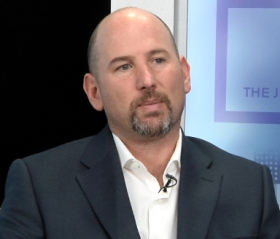 Who: Thomas Harding is the great nephew of Lieutenant Hanns Alexander, who was part of the first British War Crimes Investigation Team in the aftermath of World War II. Alexander was a German Jew serving in the British Army — and Rudolf Höss, the commandant of Auschwitz, was his most elusive target. Höss had escaped the fall of Berlin, and taken on a new identity in the German countryside, until Alexander tracked him down on a snowy night in March 1946. The story of that capture, and its repercussions for the war crimes trials at Belsen and Nuremberg, is captured in exhilarating detail within Harding’s new book, Hanns and Rudolf: The True Story Of The German Jew Who Tracked Down And Caught The Kommandant of Auschwitz. I recently interviewed Harding for The Jewish Channel, while he was in New York City promoting the book’s U.S. edition, published by Simon & Schuster. Harding discussed the extraordinary military career of his great uncle Hanns — one that Harding only became aware of upon Alexander’s death in 2006.
Who: Thomas Harding is the great nephew of Lieutenant Hanns Alexander, who was part of the first British War Crimes Investigation Team in the aftermath of World War II. Alexander was a German Jew serving in the British Army — and Rudolf Höss, the commandant of Auschwitz, was his most elusive target. Höss had escaped the fall of Berlin, and taken on a new identity in the German countryside, until Alexander tracked him down on a snowy night in March 1946. The story of that capture, and its repercussions for the war crimes trials at Belsen and Nuremberg, is captured in exhilarating detail within Harding’s new book, Hanns and Rudolf: The True Story Of The German Jew Who Tracked Down And Caught The Kommandant of Auschwitz. I recently interviewed Harding for The Jewish Channel, while he was in New York City promoting the book’s U.S. edition, published by Simon & Schuster. Harding discussed the extraordinary military career of his great uncle Hanns — one that Harding only became aware of upon Alexander’s death in 2006.
Publisher’s note: Photos from “Hanns and Rudolf” courtesy of Thomas Harding and Simon & Schuster, Inc
How did you learn about Hanns Alexander’s capture of Rudolf Hoss?
Hanns Alexander was my great uncle. He was my grandmother’s brother. And I only found out that he was a Nazi war crime investigator at his eulogy. I never knew about it. It was amazing. The family didn’t talk about it. And at the end of the Second World War, he was in Belsen. And he was part of the 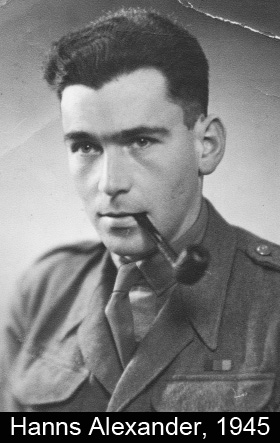 war crimes investigation team, and he ended up pursuing the people who ran the concentration camps. Including Rudolf Höss, who was hiding in a barn in the area near the Danish border of Northern Germany.
war crimes investigation team, and he ended up pursuing the people who ran the concentration camps. Including Rudolf Höss, who was hiding in a barn in the area near the Danish border of Northern Germany.
Rudolf Höss was the commandant of Auschwitz, and he set it up in 1940 — at first, as a camp for political prisoners. And then he got word from [Heinrich] Himmler, saying, “I want you to execute the final solution of the Jewish people. And I want you to transform Auschwitz into this mass-killing center.”
In 1943, Rudolf Höss was actually reassigned to help run all the concentration camps. And so he was in Berlin at the end of the war. And in April 1945, as the Allies were bombing Berlin, he and the rest of the people from the concentration inspectors decided to flee. And so they went to the most-northern part of Germany, near the Danish border, and they had this big meeting. And Himmler said, “OK, folks. The jig’s up. Just go and hide.” And so, Rudolf Höss ended up taking the identity of a man named Hanz Lang, who was a sailor, and ended up being a farm laborer for many, many months. And he lived in a barn, and he thought he’d got away with it. And he and his family were to flee to South America, like so many of the Nazi leaders. And so that’s how he ended up in the Danish border region.
So Rudolf Höss was hiding in the barn. And this is February-March, 1946. We’re 9 months after the end of the Second World War, and Rudolf Hoss thinks he’s got away with it. In the meantime, the 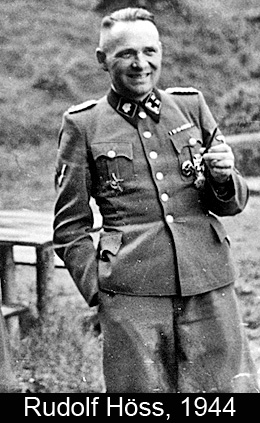 British are monitoring his wife, Hedwig, who’s hiding in plain sight with her family. And my great uncle turns up, Hanns Alexander, and says, “Let’s interview and interrogate the wife.” And they take the wife and the son — the eldest son – and they put them in jail. And he comes up with a ruse. They get this big steam engine, and they back it up to the jail. And my uncle says to Hedwig the wife, he says, “If you don’t tell us where your husband is, we’re going to send your son to Siberia.” And he says, “You’ve got ten minutes. Here’s a piece of paper. Here’s a pencil. Write down the location of your husband.’ And she did. She said, “It’s Franz Lang. He’s in the barn. He’s living in this little village called Gottrupel nearby.” So immediately, Hanns and the rest of the British troops got together, they got in the trucks, and they drove over to this tiny little village. They took with them a box of axe handles. They were definitely intent on doing some harm. Hanns was not the only Jewish soldier. There was other Jews. Partly from England, but also refugees from Austria, from Germany — people who had lost their family members in the camps. So they were obviously angry, and wanted revenge. They turn up at this tiny little village, Gottrupel. It’s the middle of the night. It’s snowing, it’s cold, it’s dark. And my great uncle knocks on the door. And the guy who opens the door is obviously Rudolf Höss. And my uncle has a photograph and he says, “You’re Rudolf Höss. You’re the Commandant.” And the guy goes, “No, I’m not. I’ve nothing to do with it. My name is Franz Lang. You’ve got it wrong.” And he shows them the papers. And my great uncle says, “OK, lets have a look at your SS tattoo, to see if you’ve got your blood type.” And actually, he’d taken it off. So he says, “Hmm, how am I gonna work this out?” And
British are monitoring his wife, Hedwig, who’s hiding in plain sight with her family. And my great uncle turns up, Hanns Alexander, and says, “Let’s interview and interrogate the wife.” And they take the wife and the son — the eldest son – and they put them in jail. And he comes up with a ruse. They get this big steam engine, and they back it up to the jail. And my uncle says to Hedwig the wife, he says, “If you don’t tell us where your husband is, we’re going to send your son to Siberia.” And he says, “You’ve got ten minutes. Here’s a piece of paper. Here’s a pencil. Write down the location of your husband.’ And she did. She said, “It’s Franz Lang. He’s in the barn. He’s living in this little village called Gottrupel nearby.” So immediately, Hanns and the rest of the British troops got together, they got in the trucks, and they drove over to this tiny little village. They took with them a box of axe handles. They were definitely intent on doing some harm. Hanns was not the only Jewish soldier. There was other Jews. Partly from England, but also refugees from Austria, from Germany — people who had lost their family members in the camps. So they were obviously angry, and wanted revenge. They turn up at this tiny little village, Gottrupel. It’s the middle of the night. It’s snowing, it’s cold, it’s dark. And my great uncle knocks on the door. And the guy who opens the door is obviously Rudolf Höss. And my uncle has a photograph and he says, “You’re Rudolf Höss. You’re the Commandant.” And the guy goes, “No, I’m not. I’ve nothing to do with it. My name is Franz Lang. You’ve got it wrong.” And he shows them the papers. And my great uncle says, “OK, lets have a look at your SS tattoo, to see if you’ve got your blood type.” And actually, he’d taken it off. So he says, “Hmm, how am I gonna work this out?” And 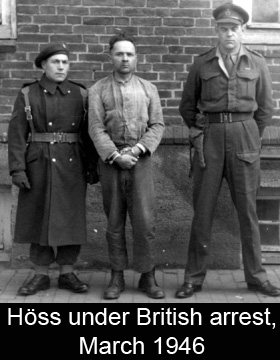 then he sees he has his wedding ring. And because my great uncle’s from Germany, he’s a Jew from Germany, he knew that often in Germany the husbands would have a wedding ring with the initials of the husband and the wife. So he says, “Give me your wedding ring.” And the commandant says, “No. I’m not gonna do that.” And my uncle said, “That’s fine.” And he says to one of his colleagues, he says, “Go and get a knife from the kitchen.” And so he’s gonna cut his finger off to be able to get the wedding ring. And of course at that stage, the commandant says, “OK.” So he hands the ring over. And of course, the initials are inside. And that’s how my great uncle established that it was the commandant of Auschwitz.
then he sees he has his wedding ring. And because my great uncle’s from Germany, he’s a Jew from Germany, he knew that often in Germany the husbands would have a wedding ring with the initials of the husband and the wife. So he says, “Give me your wedding ring.” And the commandant says, “No. I’m not gonna do that.” And my uncle said, “That’s fine.” And he says to one of his colleagues, he says, “Go and get a knife from the kitchen.” And so he’s gonna cut his finger off to be able to get the wedding ring. And of course at that stage, the commandant says, “OK.” So he hands the ring over. And of course, the initials are inside. And that’s how my great uncle established that it was the commandant of Auschwitz.
So he captured him, he puts him in a truck. It’s very late at night now. And they drive him towards Heide, a very small town where there’s a prison. Rudolf Höss is one of the most-wanted men in Europe. You know, he’s like the ace of spades. But my great uncle was a bit of a troublemaker. He should of just delivered him to the prison, and handed him over. Instead, he and his twin brother who joined them, and the rest of the guys in these couple of trucks, they stopped at a bar. And they left the commandant in the truck, under guard, and they went to have a few drinks to celebrate. And then afterwards, they took the commandant out of the truck, took all his clothes off, and made him walk 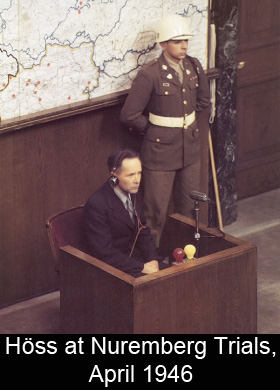 naked across the square to humiliate him. And then in the cell, they did the first interrogation, where he did confess being the commandant of Auschwitz, that he ran the camp. And then that started the whole series of interrogations by the Brits, and then by the Americans. Because the trials in Nuremberg were still going on, and the Americans there caught word that the commandant had been arrested, and they were desperate for somebody to actually say what happened in the camps. Because up to that stage, the leaders in the Nuremberg trials were saying, “Not me, sir. I didn’t know about it. I’m just a politician. I’m just in the army.” And so a young American prosecutor called Whitney Harris heard that Rudolf Höss had been captured, and thought “Ok, let’s see if we can get him to testify as a witness.” And so that’s what happened. So Rudolf Höss got transferred to Nuremberg, and he appeared as a witness in the Nuremberg trials. And his testimony changed the course of the trial. Because for the first time, somebody said, “This is what happened. This is exactly how we ran the camps, the gas chambers, the selections, the crematoria.” And the enormity of the detail persuaded the other leaders,
naked across the square to humiliate him. And then in the cell, they did the first interrogation, where he did confess being the commandant of Auschwitz, that he ran the camp. And then that started the whole series of interrogations by the Brits, and then by the Americans. Because the trials in Nuremberg were still going on, and the Americans there caught word that the commandant had been arrested, and they were desperate for somebody to actually say what happened in the camps. Because up to that stage, the leaders in the Nuremberg trials were saying, “Not me, sir. I didn’t know about it. I’m just a politician. I’m just in the army.” And so a young American prosecutor called Whitney Harris heard that Rudolf Höss had been captured, and thought “Ok, let’s see if we can get him to testify as a witness.” And so that’s what happened. So Rudolf Höss got transferred to Nuremberg, and he appeared as a witness in the Nuremberg trials. And his testimony changed the course of the trial. Because for the first time, somebody said, “This is what happened. This is exactly how we ran the camps, the gas chambers, the selections, the crematoria.” And the enormity of the detail persuaded the other leaders, 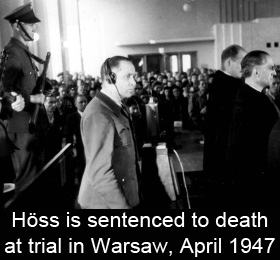 including [Hans] Frank who was the governor of Poland, and others to actually say “OK, this is what happened.” And he changed the course, and became incredibly important from an evidentiary point of view for the Holocaust. And then Rudolf Höss got passed to the Polish. Because there was an agreement amongst the Allies that war criminals would get tried in the country that they perpetrated their crimes. And so he was passed over to the Polish, where he was then tried. While in prison, he wrote his memoirs, which became an incredibly important piece of testimony for the Holocaust, known as The Autobiography of Rudolf Höss. Some people call it Death Dealer. And then he was tried. And then in April 1947, he was actually hung on a gallows next to the crematoria in Auschwitz.
including [Hans] Frank who was the governor of Poland, and others to actually say “OK, this is what happened.” And he changed the course, and became incredibly important from an evidentiary point of view for the Holocaust. And then Rudolf Höss got passed to the Polish. Because there was an agreement amongst the Allies that war criminals would get tried in the country that they perpetrated their crimes. And so he was passed over to the Polish, where he was then tried. While in prison, he wrote his memoirs, which became an incredibly important piece of testimony for the Holocaust, known as The Autobiography of Rudolf Höss. Some people call it Death Dealer. And then he was tried. And then in April 1947, he was actually hung on a gallows next to the crematoria in Auschwitz.